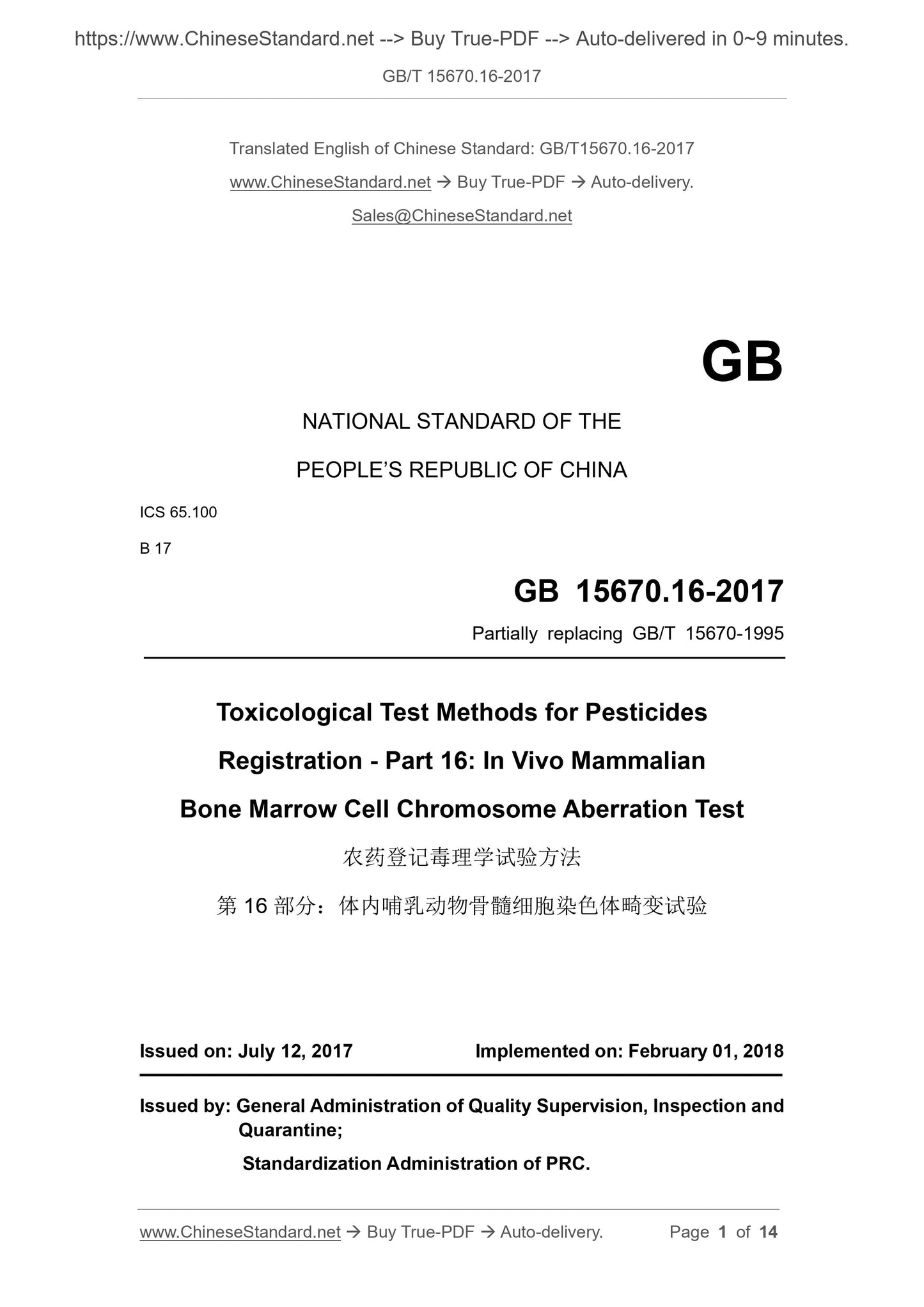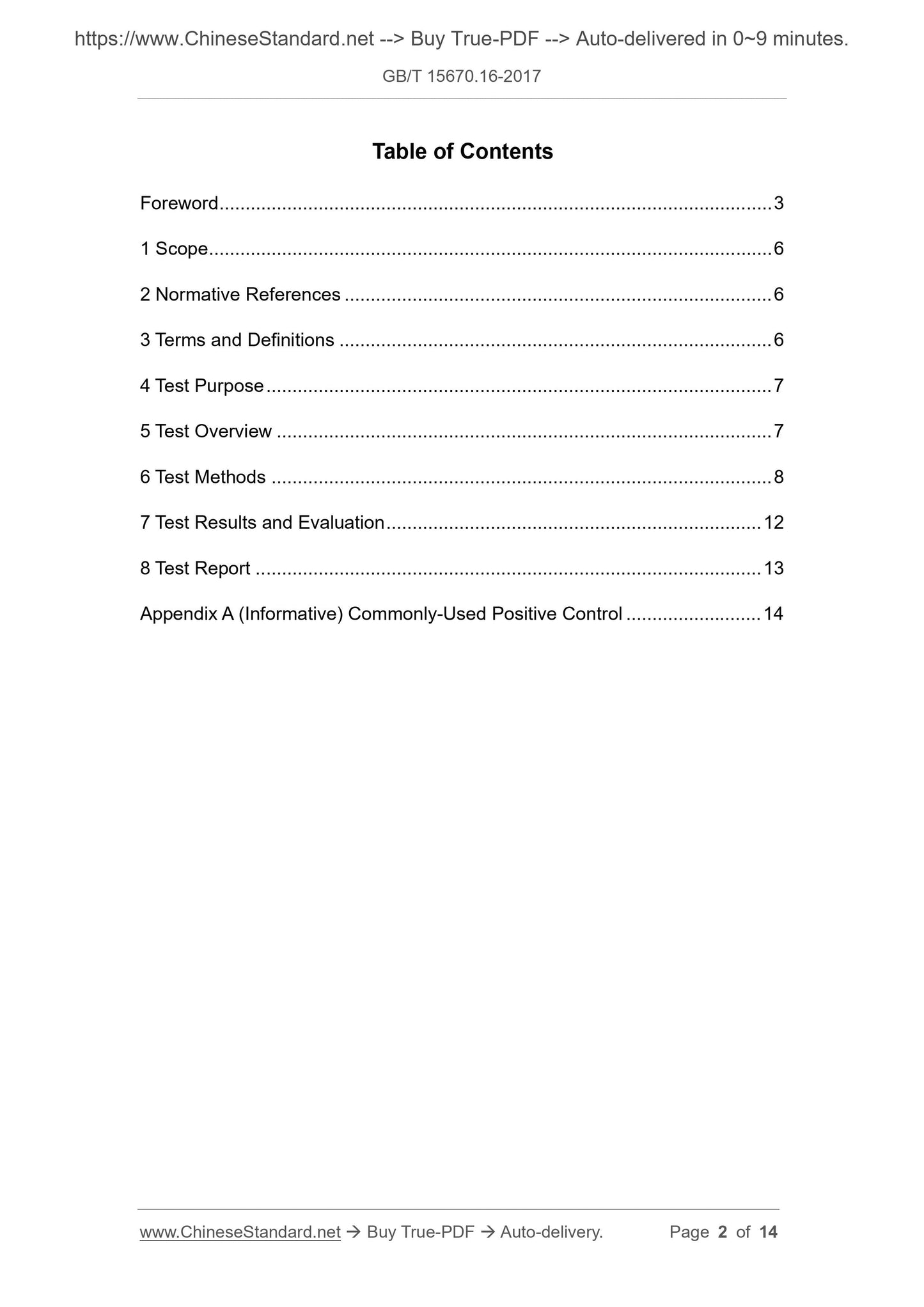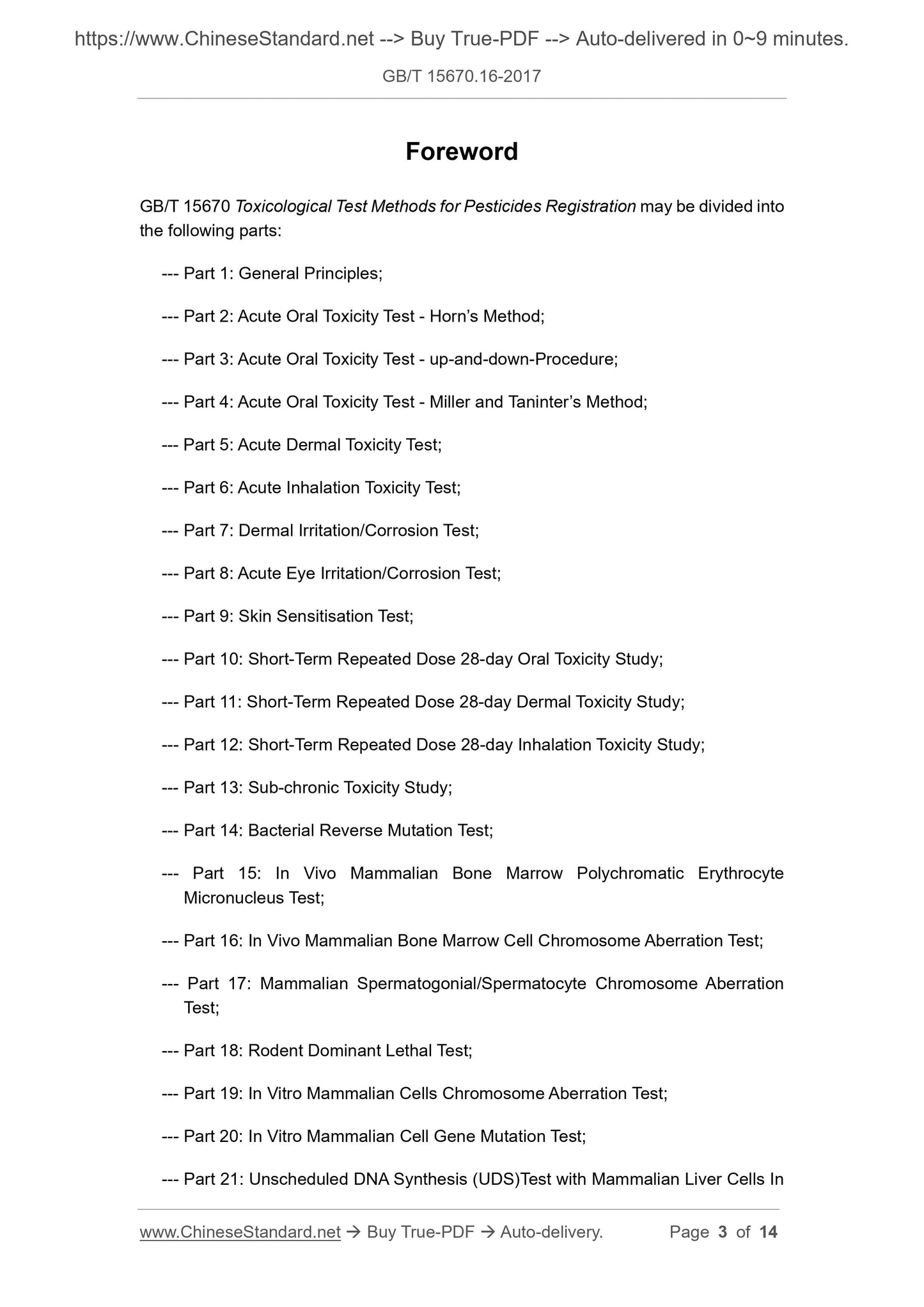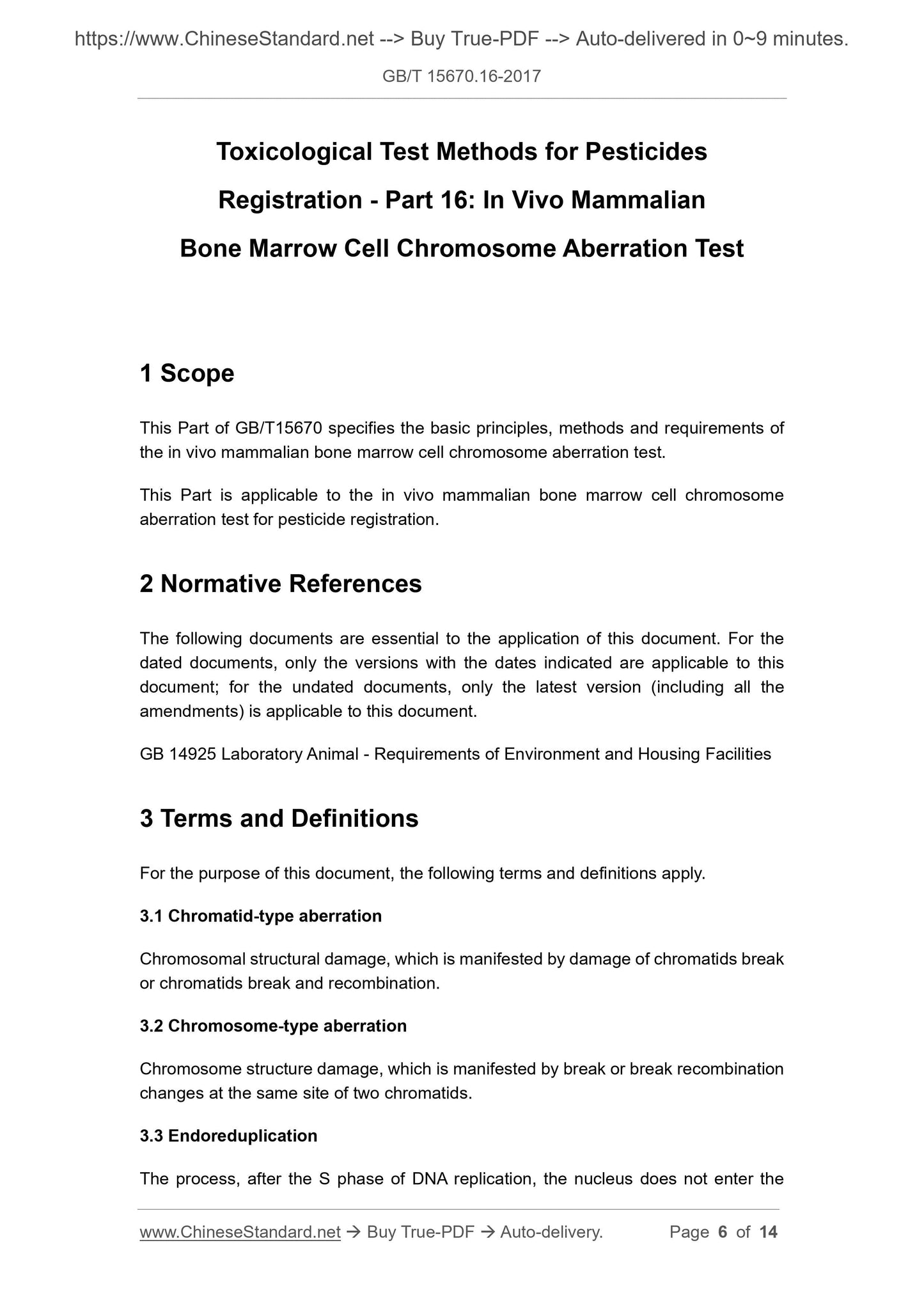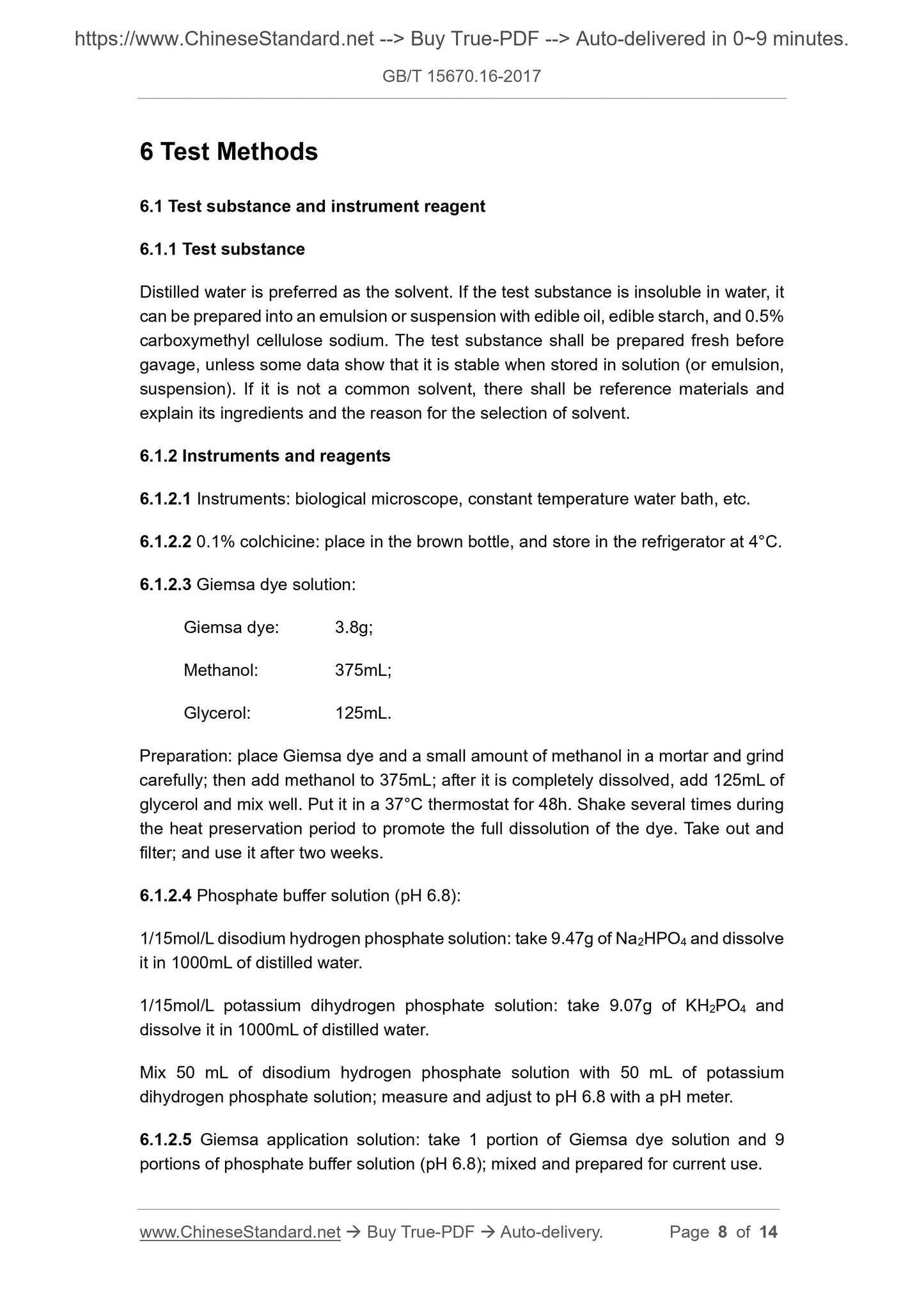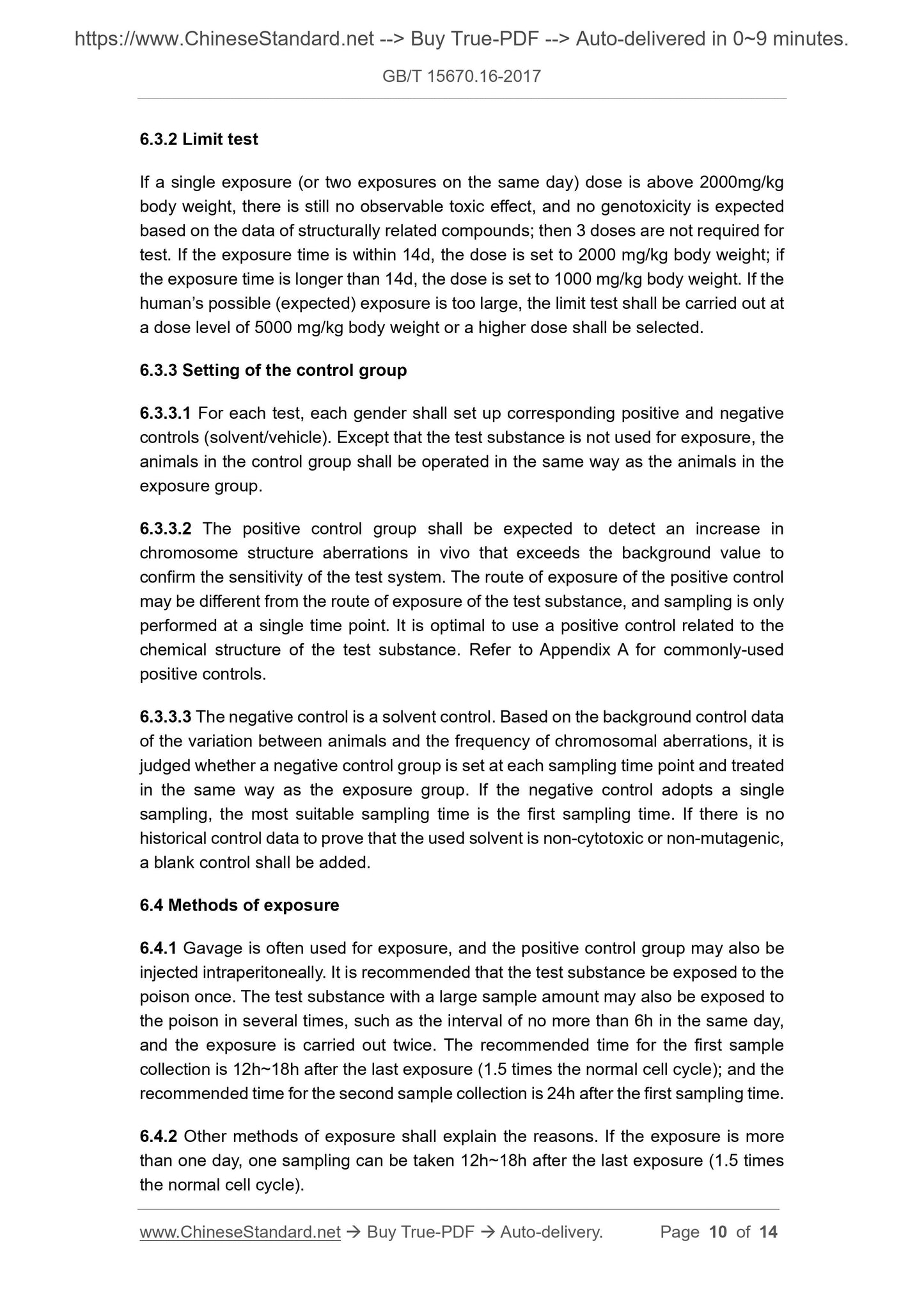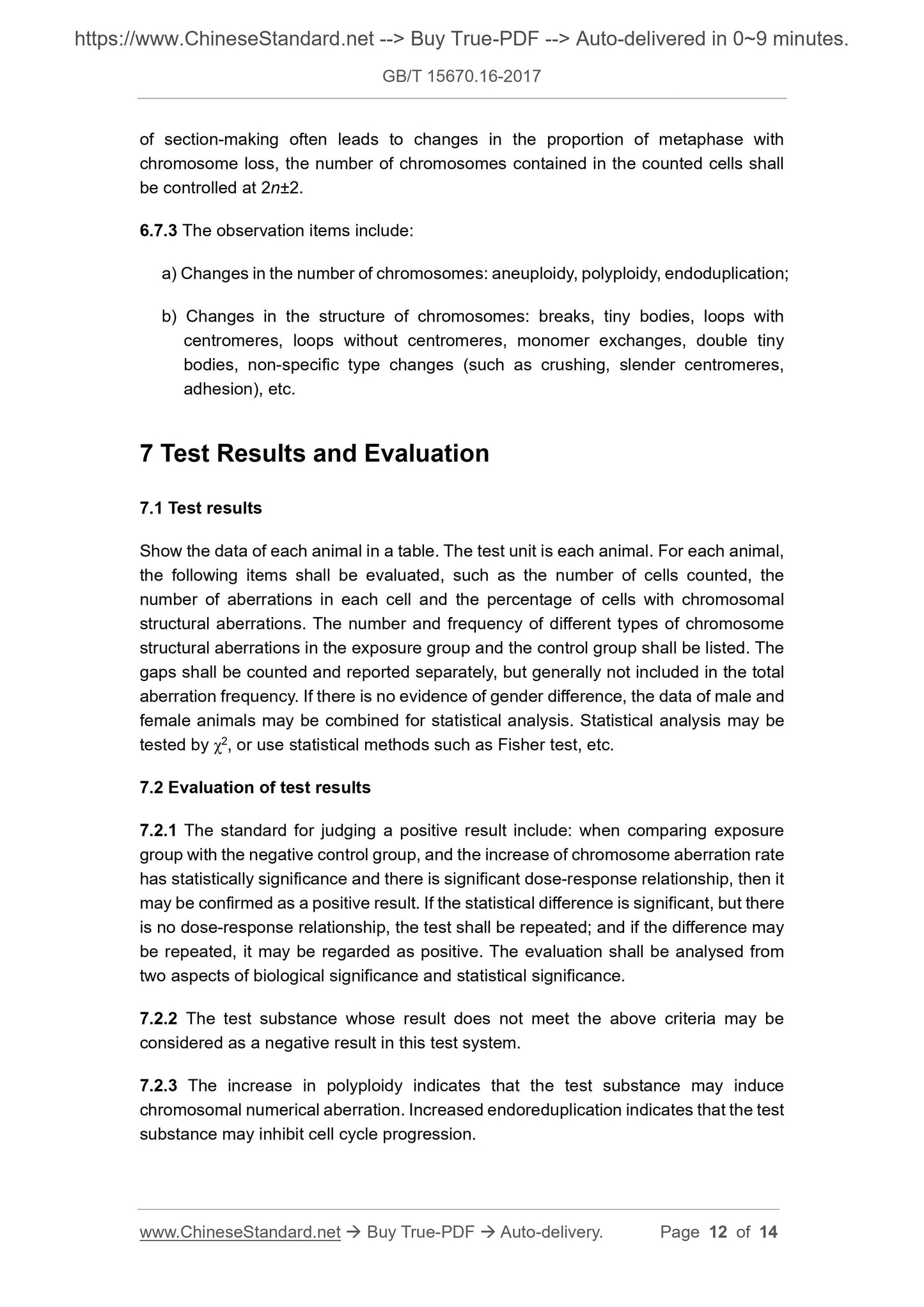1
/
of
7
PayPal, credit cards. Download editable-PDF & invoice In 1 second!
GB/T 15670.16-2017 English PDF (GBT15670.16-2017)
GB/T 15670.16-2017 English PDF (GBT15670.16-2017)
Regular price
$170.00 USD
Regular price
Sale price
$170.00 USD
Unit price
/
per
Shipping calculated at checkout.
Couldn't load pickup availability
Delivery: 3 seconds. Download true-PDF + Invoice.
Get QUOTATION in 1-minute: Click GB/T 15670.16-2017
Historical versions: GB/T 15670.16-2017
Preview True-PDF (Reload/Scroll if blank)
GB/T 15670.16-2017: Toxicological test methods for pesticides registration -- Part 16: In vivo mammalian bone marrow cell chromosome aberration test
GB/T 15670.16-2017
GB
NATIONAL STANDARD OF THE
PEOPLE’S REPUBLIC OF CHINA
ICS 65.100
B 17
GB 15670.16-2017
Partially replacing GB/T 15670-1995
Toxicological Test Methods for Pesticides
Registration - Part 16: In Vivo Mammalian
Bone Marrow Cell Chromosome Aberration Test
ISSUED ON: JULY 12, 2017
IMPLEMENTED ON: FEBRUARY 01, 2018
Issued by: General Administration of Quality Supervision, Inspection and
Quarantine;
Standardization Administration of PRC.
Table of Contents
Foreword ... 3
1 Scope ... 6
2 Normative References ... 6
3 Terms and Definitions ... 6
4 Test Purpose ... 7
5 Test Overview ... 7
6 Test Methods ... 8
7 Test Results and Evaluation ... 12
8 Test Report ... 13
Appendix A (Informative) Commonly-Used Positive Control ... 14
Foreword
GB/T 15670 Toxicological Test Methods for Pesticides Registration may be divided into
the following parts:
--- Part 1: General Principles;
--- Part 2: Acute Oral Toxicity Test - Horn’s Method;
--- Part 3: Acute Oral Toxicity Test - up-and-down-Procedure;
--- Part 4: Acute Oral Toxicity Test - Miller and Taninter’s Method;
--- Part 5: Acute Dermal Toxicity Test;
--- Part 6: Acute Inhalation Toxicity Test;
--- Part 7: Dermal Irritation/Corrosion Test;
--- Part 8: Acute Eye Irritation/Corrosion Test;
--- Part 9: Skin Sensitisation Test;
--- Part 10: Short-Term Repeated Dose 28-day Oral Toxicity Study;
--- Part 11: Short-Term Repeated Dose 28-day Dermal Toxicity Study;
--- Part 12: Short-Term Repeated Dose 28-day Inhalation Toxicity Study;
--- Part 13: Sub-chronic Toxicity Study;
--- Part 14: Bacterial Reverse Mutation Test;
--- Part 15: In Vivo Mammalian Bone Marrow Polychromatic Erythrocyte
Micronucleus Test;
--- Part 16: In Vivo Mammalian Bone Marrow Cell Chromosome Aberration Test;
--- Part 17: Mammalian Spermatogonial/Spermatocyte Chromosome Aberration
Test;
--- Part 18: Rodent Dominant Lethal Test;
--- Part 19: In Vitro Mammalian Cells Chromosome Aberration Test;
--- Part 20: In Vitro Mammalian Cell Gene Mutation Test;
--- Part 21: Unscheduled DNA Synthesis (UDS)Test with Mammalian Liver Cells In
Toxicological Test Methods for Pesticides
Registration - Part 16: In Vivo Mammalian
Bone Marrow Cell Chromosome Aberration Test
1 Scope
This Part of GB/T15670 specifies the basic principles, methods and requirements of
the in vivo mammalian bone marrow cell chromosome aberration test.
This Part is applicable to the in vivo mammalian bone marrow cell chromosome
aberration test for pesticide registration.
2 Normative References
The following documents are essential to the application of this document. For the
dated documents, only the versions with the dates indicated are applicable to this
document; for the undated documents, only the latest version (including all the
amendments) is applicable to this document.
GB 14925 Laboratory Animal - Requirements of Environment and Housing Facilities
3 Terms and Definitions
For the purpose of this document, the following terms and definitions apply.
3.1 Chromatid-type aberration
Chromosomal structural damage, which is manifested by damage of chromatids break
or chromatids break and recombination.
3.2 Chromosome-type aberration
Chromosome structure damage, which is manifested by break or break recombination
changes at the same site of two chromatids.
3.3 Endoreduplication
The process, after the S phase of DNA replication, the nucleus does not enter the
6 Test Methods
6.1 Test substance and instrument reagent
6.1.1 Test substance
Distilled water is preferred as the solvent. If the test substance is insoluble in water, it
can be prepared into an emulsion or suspension with edible oil, edible starch, and 0.5%
carboxymethyl cellulose sodium. The test substance shall be prepared fresh before
gavage, unless some data show that it is stable when stored in solution (or emulsion,
suspension). If it is not a common solvent, there shall be reference materials and
explain its ingredients and the reason for the selection of solvent.
6.1.2 Instruments and reagents
6.1.2.1 Instruments: biological microscope, constant temperature water bath, etc.
6.1.2.2 0.1% colchicine: place in the brown bottle, and store in the refrigerator at 4°C.
6.1.2.3 Giemsa dye solution:
Giemsa dye: 3.8g;
Methanol: 375mL;
Glycerol: 125mL.
Preparation: place Giemsa dye and a small amount of methanol in a mortar and grind
carefully; then add methanol to 375mL; after it is completely dissolved, add 125mL of
glycerol and mix well. Put it in a 37°C thermostat for 48h. Shake several times during
the heat preservation period to promote the full dissolution of the dye. Take out and
filter; and use it after two weeks.
6.1.2.4 Phosphate buffer solution (pH 6.8):
1/15mol/L disodium hydrogen phosphate solution: take 9.47g of Na2HPO4 and dissolve
it in 1000mL of distilled water.
1/15mol/L potassium dihydrogen phosphate solution: take 9.07g of KH2PO4 and
dissolve it in 1000mL of distilled water.
Mix 50 mL of disodium hydrogen phosphate solution with 50 mL of potassium
dihydrogen phosphate solution; measure and adjust to pH 6.8 with a pH meter.
6.1.2.5 Giemsa application solution: take 1 portion of Giemsa dye solution and 9
portions of phosphate buffer solution (pH 6.8); mixed and prepared for current use.
6.3.2 Limit test
If a single exposure (or two exposures on the same day) dose is above 2000mg/kg
body weight, there is still no observable toxic effect, and no genotoxicity is expected
based on the data of structurally related compounds; then 3 doses are not required for
test. If the exposure time is within 14d, the dose is set to 2000 mg/kg body weight; if
the exposure time is longer than 14d, the dose is set to 1000 mg/kg body weight. If the
human’s possible (expected) exposure is too large, the limit test shall be carried out at
a dose level of 5000 mg/kg body weight or a higher dose shall be selected.
6.3.3 Setting of the control group
6.3.3.1 For each test, each gender shall set up corresponding positive and negative
controls (solvent/vehicle). Except that the test substance is not used for exposure, the
animals in the control group shall be operated in the same way as the animals in the
exposure group.
6.3.3.2 The positive control group shall be expected to detect an increase in
chromosome structure aberrations in vivo that exceeds the background value to
confirm the sensitivity of the test system. The route of exposure of the positive control
may be different from the route of exposure of the test substance, and sampling is only
performed at a single time point. It is optimal to use a positive control related to the
chemical structure of the test substance. Refer to Appendix A for commonly-used
positive controls.
6.3.3.3 The negative control is a solvent control. Based on the background control data
of the variation between animals and the frequency of chromosomal aberrations, it is
judged whether a negative control group is set at each sampling time point and treated
in the same way as the exposure group. If the negative control adopts a single
sampling, the most suitable sampling time is the first sampling time. If there is no
historical control data to prove that the used solvent is non-cytotoxic or non-mutagenic,
a blank control shall be added.
6.4 Methods of exposure
6.4.1 Gavage is often used for exposure, and the positive control group may also be
in...
Get QUOTATION in 1-minute: Click GB/T 15670.16-2017
Historical versions: GB/T 15670.16-2017
Preview True-PDF (Reload/Scroll if blank)
GB/T 15670.16-2017: Toxicological test methods for pesticides registration -- Part 16: In vivo mammalian bone marrow cell chromosome aberration test
GB/T 15670.16-2017
GB
NATIONAL STANDARD OF THE
PEOPLE’S REPUBLIC OF CHINA
ICS 65.100
B 17
GB 15670.16-2017
Partially replacing GB/T 15670-1995
Toxicological Test Methods for Pesticides
Registration - Part 16: In Vivo Mammalian
Bone Marrow Cell Chromosome Aberration Test
ISSUED ON: JULY 12, 2017
IMPLEMENTED ON: FEBRUARY 01, 2018
Issued by: General Administration of Quality Supervision, Inspection and
Quarantine;
Standardization Administration of PRC.
Table of Contents
Foreword ... 3
1 Scope ... 6
2 Normative References ... 6
3 Terms and Definitions ... 6
4 Test Purpose ... 7
5 Test Overview ... 7
6 Test Methods ... 8
7 Test Results and Evaluation ... 12
8 Test Report ... 13
Appendix A (Informative) Commonly-Used Positive Control ... 14
Foreword
GB/T 15670 Toxicological Test Methods for Pesticides Registration may be divided into
the following parts:
--- Part 1: General Principles;
--- Part 2: Acute Oral Toxicity Test - Horn’s Method;
--- Part 3: Acute Oral Toxicity Test - up-and-down-Procedure;
--- Part 4: Acute Oral Toxicity Test - Miller and Taninter’s Method;
--- Part 5: Acute Dermal Toxicity Test;
--- Part 6: Acute Inhalation Toxicity Test;
--- Part 7: Dermal Irritation/Corrosion Test;
--- Part 8: Acute Eye Irritation/Corrosion Test;
--- Part 9: Skin Sensitisation Test;
--- Part 10: Short-Term Repeated Dose 28-day Oral Toxicity Study;
--- Part 11: Short-Term Repeated Dose 28-day Dermal Toxicity Study;
--- Part 12: Short-Term Repeated Dose 28-day Inhalation Toxicity Study;
--- Part 13: Sub-chronic Toxicity Study;
--- Part 14: Bacterial Reverse Mutation Test;
--- Part 15: In Vivo Mammalian Bone Marrow Polychromatic Erythrocyte
Micronucleus Test;
--- Part 16: In Vivo Mammalian Bone Marrow Cell Chromosome Aberration Test;
--- Part 17: Mammalian Spermatogonial/Spermatocyte Chromosome Aberration
Test;
--- Part 18: Rodent Dominant Lethal Test;
--- Part 19: In Vitro Mammalian Cells Chromosome Aberration Test;
--- Part 20: In Vitro Mammalian Cell Gene Mutation Test;
--- Part 21: Unscheduled DNA Synthesis (UDS)Test with Mammalian Liver Cells In
Toxicological Test Methods for Pesticides
Registration - Part 16: In Vivo Mammalian
Bone Marrow Cell Chromosome Aberration Test
1 Scope
This Part of GB/T15670 specifies the basic principles, methods and requirements of
the in vivo mammalian bone marrow cell chromosome aberration test.
This Part is applicable to the in vivo mammalian bone marrow cell chromosome
aberration test for pesticide registration.
2 Normative References
The following documents are essential to the application of this document. For the
dated documents, only the versions with the dates indicated are applicable to this
document; for the undated documents, only the latest version (including all the
amendments) is applicable to this document.
GB 14925 Laboratory Animal - Requirements of Environment and Housing Facilities
3 Terms and Definitions
For the purpose of this document, the following terms and definitions apply.
3.1 Chromatid-type aberration
Chromosomal structural damage, which is manifested by damage of chromatids break
or chromatids break and recombination.
3.2 Chromosome-type aberration
Chromosome structure damage, which is manifested by break or break recombination
changes at the same site of two chromatids.
3.3 Endoreduplication
The process, after the S phase of DNA replication, the nucleus does not enter the
6 Test Methods
6.1 Test substance and instrument reagent
6.1.1 Test substance
Distilled water is preferred as the solvent. If the test substance is insoluble in water, it
can be prepared into an emulsion or suspension with edible oil, edible starch, and 0.5%
carboxymethyl cellulose sodium. The test substance shall be prepared fresh before
gavage, unless some data show that it is stable when stored in solution (or emulsion,
suspension). If it is not a common solvent, there shall be reference materials and
explain its ingredients and the reason for the selection of solvent.
6.1.2 Instruments and reagents
6.1.2.1 Instruments: biological microscope, constant temperature water bath, etc.
6.1.2.2 0.1% colchicine: place in the brown bottle, and store in the refrigerator at 4°C.
6.1.2.3 Giemsa dye solution:
Giemsa dye: 3.8g;
Methanol: 375mL;
Glycerol: 125mL.
Preparation: place Giemsa dye and a small amount of methanol in a mortar and grind
carefully; then add methanol to 375mL; after it is completely dissolved, add 125mL of
glycerol and mix well. Put it in a 37°C thermostat for 48h. Shake several times during
the heat preservation period to promote the full dissolution of the dye. Take out and
filter; and use it after two weeks.
6.1.2.4 Phosphate buffer solution (pH 6.8):
1/15mol/L disodium hydrogen phosphate solution: take 9.47g of Na2HPO4 and dissolve
it in 1000mL of distilled water.
1/15mol/L potassium dihydrogen phosphate solution: take 9.07g of KH2PO4 and
dissolve it in 1000mL of distilled water.
Mix 50 mL of disodium hydrogen phosphate solution with 50 mL of potassium
dihydrogen phosphate solution; measure and adjust to pH 6.8 with a pH meter.
6.1.2.5 Giemsa application solution: take 1 portion of Giemsa dye solution and 9
portions of phosphate buffer solution (pH 6.8); mixed and prepared for current use.
6.3.2 Limit test
If a single exposure (or two exposures on the same day) dose is above 2000mg/kg
body weight, there is still no observable toxic effect, and no genotoxicity is expected
based on the data of structurally related compounds; then 3 doses are not required for
test. If the exposure time is within 14d, the dose is set to 2000 mg/kg body weight; if
the exposure time is longer than 14d, the dose is set to 1000 mg/kg body weight. If the
human’s possible (expected) exposure is too large, the limit test shall be carried out at
a dose level of 5000 mg/kg body weight or a higher dose shall be selected.
6.3.3 Setting of the control group
6.3.3.1 For each test, each gender shall set up corresponding positive and negative
controls (solvent/vehicle). Except that the test substance is not used for exposure, the
animals in the control group shall be operated in the same way as the animals in the
exposure group.
6.3.3.2 The positive control group shall be expected to detect an increase in
chromosome structure aberrations in vivo that exceeds the background value to
confirm the sensitivity of the test system. The route of exposure of the positive control
may be different from the route of exposure of the test substance, and sampling is only
performed at a single time point. It is optimal to use a positive control related to the
chemical structure of the test substance. Refer to Appendix A for commonly-used
positive controls.
6.3.3.3 The negative control is a solvent control. Based on the background control data
of the variation between animals and the frequency of chromosomal aberrations, it is
judged whether a negative control group is set at each sampling time point and treated
in the same way as the exposure group. If the negative control adopts a single
sampling, the most suitable sampling time is the first sampling time. If there is no
historical control data to prove that the used solvent is non-cytotoxic or non-mutagenic,
a blank control shall be added.
6.4 Methods of exposure
6.4.1 Gavage is often used for exposure, and the positive control group may also be
in...
Share
